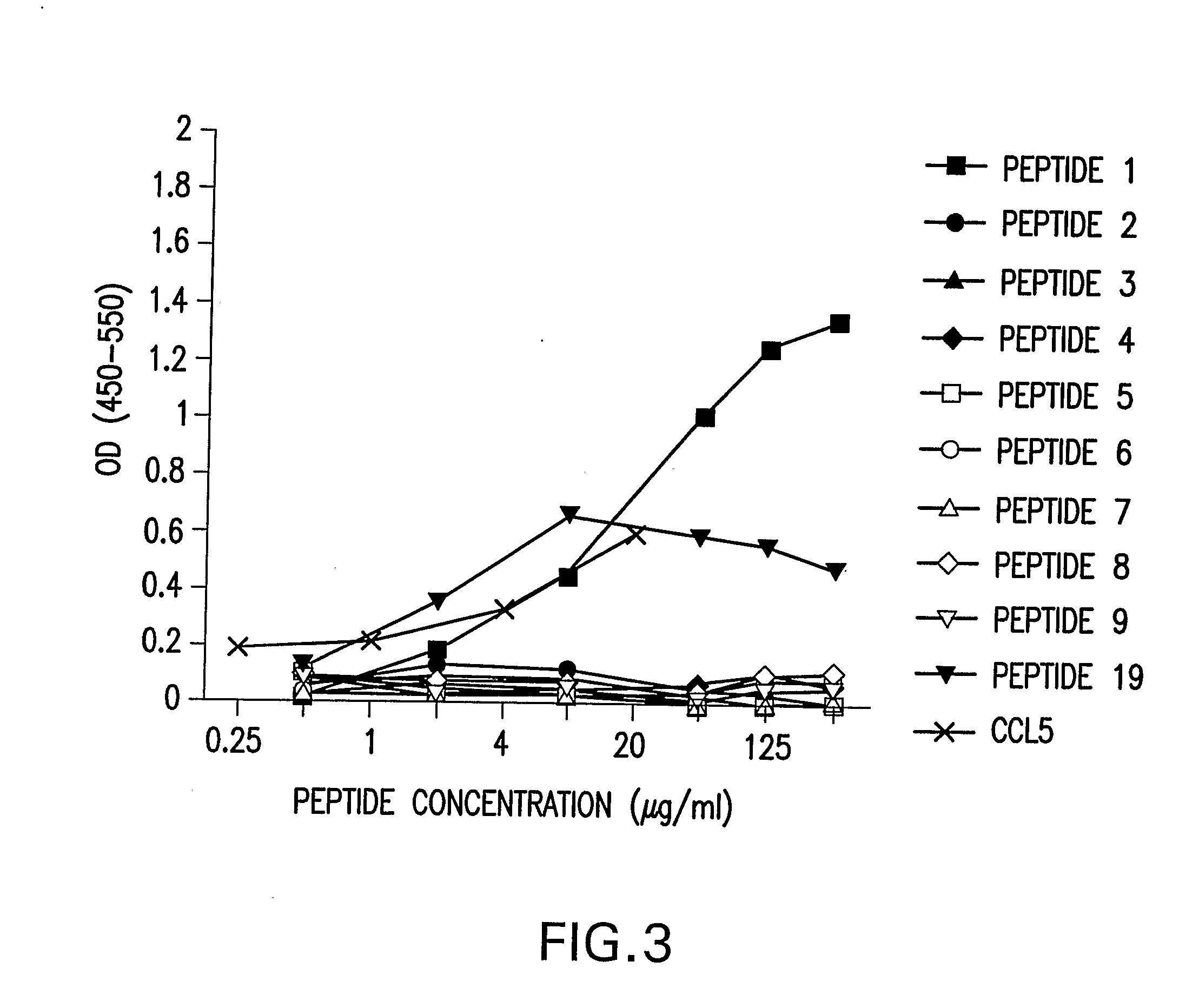Antiviral compositions which inhibit paramyxovirus infection
a technology of antiviral compositions and paramyxovirus, which is applied in the field of antiviral compositions which inhibit paramyxovirus infection, can solve the problems of ribavirin being a teratogen, posing safety-risks to hospital staff, parents,
- Summary
- Abstract
- Description
- Claims
- Application Information
AI Technical Summary
Benefits of technology
Problems solved by technology
Method used
Image
Examples
example 1
Materials and Methods
[0101] Chemokines and reagents. Unless indicated otherwise, all recombinant (r) human chemokines and anti-human chemokine receptor antibodies were purchased from R & D Systems Inc. (Minneapolis, Minn.). Recombinant human CCL5 and stromal cell derived factor (SDF)-1α (CXCL12) were obtained respectively from Biosource International (Camarillo, Calif.) and Wyeth (Andover, Mass.). Both monoclonal and polyclonal antibodies against CC chemokine receptors (CCR) were used in the studies. The monoclonal antibodies (mAb) were directed against human CCR3 (catalog No. MAB155) or CCR5 (catalog No. MAB182). Affinity purified polyclonal antibodies raised against peptides sequences from CCR1 (catalogue No. sc-7934), CCR3 (catalog No. sc-7897), CCR4 (catalog No. sc-6126) or CCR5 (catalog No. sc-8283) were purchased from Santa Cruz Biotechnology (Santa Cruz, Calif.). Anti human CX3CR1 polyclonal antibody (catalogue No. TP502AF) was purchased from Torrey Pines Biolabs (Houston, T...
example 2
CCL5 Inhibits Infection of Epithelial Cells with RSV
[0110] In this example, it was demonstrated in vitro that human airway epithelial cells produced CCL5 polypeptide in response to infection with RSV. Table 8 and Table 9 show representative results from experiments that respectively examined the effects of RSV infection on quantitative increases in mRNA copy number and secretion of CCL5 from A549 and HEp-2 cell monolayers. In A549 monolayers, CCL5 mRNA copy number increased two days (seven fold) and three days (twenty fold) after infection (Table 8). The data further indicated that as RSV replication progressed, the number of CCL5 transcripts dramatically increased relative to RSV genome copy number (Table 8). The ratio of CCL5 mRNA to RSV genome copy number increased sixteen fold between days one and three of culture. CCL5 protein was detected in culture supernatants as early as 24 hours after infection (Table 9). Thus, in response to RSV infection, the monolayers secreted increas...
example 3
CCL5 Blocks the Interaction Between the Epithelial Cell and the Fusion (F) Protein of RSV
[0116] To ascertain whether inhibition of infection occurred directly by blocking virus interactions with cell surface ligands, or secondarily to outside in signaling pathways following ligand-receptor interactions, experiments were performed with rCCL5 that retained the N-terminal methionine (met)-CCL5 (Proudfoot et al., 1996). Met-CCL5 retains the initiating methionine and upon receptor binding is not biologically active (Simmons et al., 2000). At the greatest dose tested (20 μg met-CCL5 / ml) infectivity was approximately 25% of control cells (FIG. 1). The inhibitory properties of met-CCL5 were also dependent on dose. Prior treatment with 1.25 μg met-CCL5 / ml resulted in approximately 80% infectivity, while doses of 0.313 or 0.156 μg met-CCL5 / ml were not inhibitory. Inhibition of replication was also tested when both infection and administration of rCCL5 were performed sequentially at 4° C. to ...
PUM
| Property | Measurement | Unit |
|---|---|---|
| molecular weight | aaaaa | aaaaa |
| molecular weight | aaaaa | aaaaa |
| chemical structures | aaaaa | aaaaa |
Abstract
Description
Claims
Application Information
 Login to View More
Login to View More - R&D
- Intellectual Property
- Life Sciences
- Materials
- Tech Scout
- Unparalleled Data Quality
- Higher Quality Content
- 60% Fewer Hallucinations
Browse by: Latest US Patents, China's latest patents, Technical Efficacy Thesaurus, Application Domain, Technology Topic, Popular Technical Reports.
© 2025 PatSnap. All rights reserved.Legal|Privacy policy|Modern Slavery Act Transparency Statement|Sitemap|About US| Contact US: help@patsnap.com



